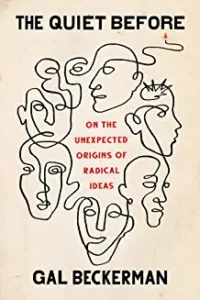The Quiet Before: On the Unexpected Origins of Radical Ideas by Gal Beckerman 2022
Recommended by a friend, this book is blurbed on the back cover by a number of writers and thinkers of renown—Louis Menand, Susan Orlean, Walter Isaacson, and Andrew Solomon. It deserves all of that praise.
Beckerman, an editor for the New York Times Sunday Book Review, has written a fascinating book which probes the question of how radical ideas arise and either take hold in the world or drop by the wayside. Starting with the story of a French amateur scientist, Nicolas-Claude Fabre de Pieresc who devised a method to determine the size of the Mediterranean Sea in 1635 through writing letters with detailed instructions to his collaborators through the Black Lives Matter hashtag of recent years, the author weaves interesting details of often obscure historical events (e.g. the Chartist movement in 19th C. England) and identifies the low-tech, slow moving methods which in the past have enabled conversation, discussion, and eventual refinement of an idea until it powerfully exploded into the wider world. Letters, petitions, manifestos, local newspapers, samizdat (secret handbills in Stalinist Russia), and zines all provided incubators for radical ideas which eventually became mainstream and changed the world.
In contrast, today’s social media forums like Twitter and Facebook eliminate this potential for conversation, exchange, refinement, and development. They are long on accumulation ( friends or hits), but short on substance and process. As an example, Beckerman writes about the Arab Spring and how the Egyptian mobilization of citizens in Tahir Square via social media failed to lead to lasting change because the movement was long on flash and fire, but short on a process and a base that would lead to political power.
In contrast, Beckerman points to the white supremacist’s use of other internet portals which allowed agreement and organization among disparate groups before the Charlottesville march in 2017 though violence eventually undid that effort. A similar use of private chat rooms enabled physicians and scientists to distribute accurate information during the early days of COVID to counteract the official administration’s deceptions and lies and save lives. Finally, Beckerman uses the Black Lives Matter’s move from major social media sites which failed to sustain energy between violent events to private chat rooms where strategy and political power could be planned.
The Epilogue pulls all of this together in a masterful way, using Hannah Arendt’s metaphor of a table as something concrete and solid that unlike social media, can bring people together to argue, discuss, reformulate, and establish the soft and then the hard power to change the world.
I’m still processing this important book which I highly recommend.



